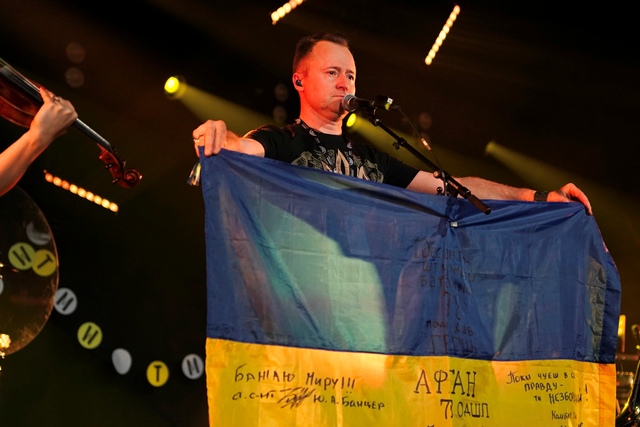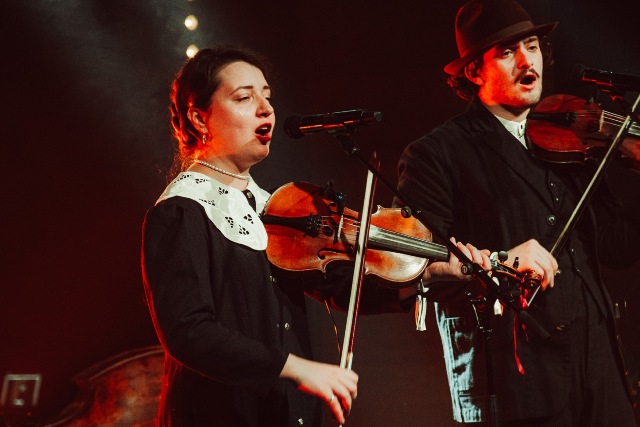Tallinn Music Week 2025 review - Estonia’s capital accommodates all flavours of music | reviews, news & interviews
Tallinn Music Week 2025 review - Estonia’s capital accommodates all flavours of music
Tallinn Music Week 2025 review - Estonia’s capital accommodates all flavours of music
The festival where everything appears on an equal footing

Langenu are a black metal band. On stage at Estonia’s Tallinn Music Week, they are fearsome. Blood-vessel-burstingly intense. Tempering their force with twists into progressive, psychedelic-adjacent territory, they are a band any rock fan would dig.
Playing an evening dedicated to the region’s Finno-Ugric culture, Langenu stand apart. Folk or traditional music is typical to this realm. Rock, in any form, is not. This is a first. They are here because their last release, the Setooniq EP, is sung entirely in the Seto language.
 Seto, like Estonian, Finnish and Sámi, is a Finno-Ugric language. The root is Hungarian, which began spreading north around four millennia ago. Although there are between 15,000 to 20,000 Seto people throughout Estonia, around a tenth still live in Setomaa in the country’s south-east. There are probably 15,000 speakers overall of Seto. Within Estonia, Võro is a third Finno-Ugric language – while more widespread than Seto, it is still a minority language. (pictured right, Svjata Vatra at Tallinn Music Week 2025. Photo by Danja de Jonckheere)
Seto, like Estonian, Finnish and Sámi, is a Finno-Ugric language. The root is Hungarian, which began spreading north around four millennia ago. Although there are between 15,000 to 20,000 Seto people throughout Estonia, around a tenth still live in Setomaa in the country’s south-east. There are probably 15,000 speakers overall of Seto. Within Estonia, Võro is a third Finno-Ugric language – while more widespread than Seto, it is still a minority language. (pictured right, Svjata Vatra at Tallinn Music Week 2025. Photo by Danja de Jonckheere)
Based in Tartu, south Estonia, Langenu formed in 2004. Their frontman goes by the name 1695, referencing the year The Great Famine of Estonia began. By 1697, a fifth of the population had died. At this point, Tartu was under Swedish control as part of Livonia. Presumably, Langenu are not going to sing about June, moon and spoon.
 The five-song set features three tracks from the Setooniq EP: “Ellävhõpõ,” “Kuukerä” and “Jälle Elläj.” Another song, titled “Sõktõtsõõr,” has lyrics – helpfully translated by Estonian folk musician and Võro speaker Mark Kalkun – describing a God who relocates a mountain and steals fire. Setomaa never lost its pre-Christian traditions. The language employed doesn’t matter as the band is so impactful, but the overriding motivation is inescapable: choosing to celebrate Seto is a cultural-political decision. (pictured left, Hraybery at Tallinn Music Week 2025. Photo by Jürgen Joost)
The five-song set features three tracks from the Setooniq EP: “Ellävhõpõ,” “Kuukerä” and “Jälle Elläj.” Another song, titled “Sõktõtsõõr,” has lyrics – helpfully translated by Estonian folk musician and Võro speaker Mark Kalkun – describing a God who relocates a mountain and steals fire. Setomaa never lost its pre-Christian traditions. The language employed doesn’t matter as the band is so impactful, but the overriding motivation is inescapable: choosing to celebrate Seto is a cultural-political decision. (pictured left, Hraybery at Tallinn Music Week 2025. Photo by Jürgen Joost)
By showcasing the thrilling Langenu, Tallinn Music Week – first held in 2009 – underlines that this festival seamlessly accommodates all flavours of music. Everything playing the three-day event appears on an equal footing. There is no distinction drawn in the booking policy between Seto-metal and indie rock, between EDM and jazz. On it goes, encompassing folk, funk and the uncategorisable. All and more are welcome. On the busiest day, ten venues run shows in parallel; most located in the Telliskivi district, a former industrial enclave a five-minute tram ride from the city centre. Individual venues adopt themes: for example “Africa Now,” “Classical Next,” “Dark Disco,” “Funk Embassy,” “Jazz Stage,” “Roots Session,” Metal Stage,” “Taiwan Music Flight,” “Viljandi Folk Music Festival.”
 This means that within Tallinn Music Week, the choice can be made to create a bespoke, self-defined festival. To see folk music only, say. Or, whatever the issues with the label, world music – to see the music which has come here from other regions of the world. Maybe to exclusively go for dance music. Or dive into indie rock. It could also be done by country or region: possibly plumping for the Baltic states only – Estonia, Latvia, Lithuania. The festivals within a festival aspect of Tallinn Music Week isn’t about eclecticism, more the decision that Estonia can accommodate it all, that barriers are unnecessary – that all these distinctive approaches can exist side-by-side without conflict. It’s in keeping with the neoliberal economic model Estonia adopted after achieving independence from the Soviet Union in 1991. (pictured right, Kuula Hetke at Tallinn Music Week 2025. Photo by Grete Teigamägi)
This means that within Tallinn Music Week, the choice can be made to create a bespoke, self-defined festival. To see folk music only, say. Or, whatever the issues with the label, world music – to see the music which has come here from other regions of the world. Maybe to exclusively go for dance music. Or dive into indie rock. It could also be done by country or region: possibly plumping for the Baltic states only – Estonia, Latvia, Lithuania. The festivals within a festival aspect of Tallinn Music Week isn’t about eclecticism, more the decision that Estonia can accommodate it all, that barriers are unnecessary – that all these distinctive approaches can exist side-by-side without conflict. It’s in keeping with the neoliberal economic model Estonia adopted after achieving independence from the Soviet Union in 1991. (pictured right, Kuula Hetke at Tallinn Music Week 2025. Photo by Grete Teigamägi)
It also means that noteworthy juxtapositions frequently crop up. Langenu’s freighted-with-meaning appearance at what might customarily be a folk/traditional musical showcase is one example. At the Von Krahl venue, Estonian Eurovision entrant Alika and her R&B pop follows an appearance by Svjata Vatra, the Estonia-based punk-folk band led by Ukraine’s Ruslan Trochynskyi. He ensures the audience knows about the country where he was born. Less overtly, it is the same with Hraybery, a wondrous quartet playing Erinevate Tubade Klubi. From Poland, they focus on the music of the late 19th century typical to the Poland/Ukraine border region, showcasing cross-pollinations: including between Jewish and Roma music. The audience spontaneously dance, knowing full well that such amalgamations can today be anathema.
 A few minutes walk away at D3, the audience also suddenly begins moving to Kuula Hetke, a tradition-rooted flute duo subtly embracing electronica. The mass breakout of labajalg (the flatfoot) accompanies a music which, in its hypnotic repetition, evokes Terry Riley and aspects of kosmiche music. Folk, but reframed. Similarly calling to mind some of Germany’s music are the remarkable Skopje, Macedonia duo Alembic (Алембик) at F-hoone. At first, Iva Damjanovski (analogue synth, keyboards, theremin, vocals,) and Viktor Tanaskovski (electric guitar) come across as deeply immersed in Brian Eno and Robert Fripp’s No Pussyfooting. Other touchstones bubble up: Ash Ra Temple, Popul Vuh, Six Organs of Admittance. There’s an effortlessness, a freshness which envelopes along with a cumulative awareness that Alembic are carving their own path. (pictured left, Alembic at Tallinn Music Week 2025. Photo by Kaarel Antonov)
A few minutes walk away at D3, the audience also suddenly begins moving to Kuula Hetke, a tradition-rooted flute duo subtly embracing electronica. The mass breakout of labajalg (the flatfoot) accompanies a music which, in its hypnotic repetition, evokes Terry Riley and aspects of kosmiche music. Folk, but reframed. Similarly calling to mind some of Germany’s music are the remarkable Skopje, Macedonia duo Alembic (Алембик) at F-hoone. At first, Iva Damjanovski (analogue synth, keyboards, theremin, vocals,) and Viktor Tanaskovski (electric guitar) come across as deeply immersed in Brian Eno and Robert Fripp’s No Pussyfooting. Other touchstones bubble up: Ash Ra Temple, Popul Vuh, Six Organs of Admittance. There’s an effortlessness, a freshness which envelopes along with a cumulative awareness that Alembic are carving their own path. (pictured left, Alembic at Tallinn Music Week 2025. Photo by Kaarel Antonov)
Of course, more straightforward approaches also have an effect. Paavli Kultuurivabrik, in a former fish-processing facility, is a quick tram ride west. There, Estonia’s Mariin K takes My Bloody Valentine, Slowdive and Teenage Fanclub to turn them into a dreamy pop which cocoons like a snug sweater. Back in Telliskivi and on stage at Fotografiska, Iceland’s Oyama operate in similar territory, but have harder edges and a more aggressive attack which posits them as a sharp-elbowed cousin of Beach House. Also at Fotografiska, Tanzania’s Sisso & Maiko fuse super-fast BPM with keyboard lines picking out two- and three-note riffs and incongruous samples (car noises, Xmas tunes). An absolute frenzy, it is the equivalent of being assaulted – in a good way, that is. The latter also applies to Riga, Latvia’s All In Measure within the garden centre-ish sheds of Uus Laine who, once they’ve shrugged off the shadow of Red Hot Chili Peppers, settle into a smile-inducing hard-rocking pop-grunge.
 Latvia, Tanzania, Iceland, Macedonia, Poland, Ukraine. All are at Tallinn Music Week alongside other countries, and Estonia too. Playing this festival in her home country Mari Kalkun – she is magical at Erinevate Tubade Klubi – reflects that “compared to Europe or the rest of the world Estonia is a tiny place. You have to go outside to be able to realise it is small!” Her last album, Stories of Stonia, was released by the UK’s Real World Records – the label founded in 1989 by Peter Gabriel. She has joined a roster including artists from all continents and is, quite probably, the first Estonian musician to sign directly to a UK label. “I have really strong support from the Estonian audience,” she continues. “I have experienced that there are people who like my music outside Estonia. I am so happy, so surprised to have to found my people out there.” (pictured right, Mari Kalkun at Tallinn Music Week 2025. Photo by Jürgen Joost)
Latvia, Tanzania, Iceland, Macedonia, Poland, Ukraine. All are at Tallinn Music Week alongside other countries, and Estonia too. Playing this festival in her home country Mari Kalkun – she is magical at Erinevate Tubade Klubi – reflects that “compared to Europe or the rest of the world Estonia is a tiny place. You have to go outside to be able to realise it is small!” Her last album, Stories of Stonia, was released by the UK’s Real World Records – the label founded in 1989 by Peter Gabriel. She has joined a roster including artists from all continents and is, quite probably, the first Estonian musician to sign directly to a UK label. “I have really strong support from the Estonian audience,” she continues. “I have experienced that there are people who like my music outside Estonia. I am so happy, so surprised to have to found my people out there.” (pictured right, Mari Kalkun at Tallinn Music Week 2025. Photo by Jürgen Joost)
At first glance, then, it may seem that Estonia’s embrace of the international music business and Tallinn Music Week’s yen to provide platforms to music from elsewhere are quixotic, yet there is an engrained background suggesting that internationalism – whether desired or not – is embedded in the country. At various times, due to its strategic location on the south side of the Gulf of Finland, Estonia has been in the hands of Denmark, Germany and Sweden. Russia held the region in the 18th and 19th centuries, and after an earlier 20th-century period of independence, absorbed it into the USSR after World War II. All the while, trade was taking place: in the Viking era, Estonia was on the route to Istanbul; in 1285 the Hanseatic League established a trading station; Swedish merchants settled in Tallinn. Whether or not Estonians wanted any of this, international links became entrenched.
Independence finally came in 1991 – through what was dubbed “The Singing Revolution.” Estonia’s deep-seated relationship with music was central to this. Seen in this context, Tallinn Music Week ceases to be an apparent non sequitur. If outsiders could import and export anything, why shouldn’t Estonians do it themselves and help their music and music from elsewhere reach the rest of the world? And do so while recognising barriers are unnecessary. It doesn’t matter if it’s Seto-metal, dreamy shoegazing pop or a folk- electronica hybrid, Tallinn Music Week wants to help it all find an audience.
Share this article
The future of Arts Journalism
You can stop theartsdesk.com closing!
We urgently need financing to survive. Our fundraising drive has thus far raised £49,000 but we need to reach £100,000 or we will be forced to close. Please contribute here: https://gofund.me/c3f6033d
And if you can forward this information to anyone who might assist, we’d be grateful.

Subscribe to theartsdesk.com
Thank you for continuing to read our work on theartsdesk.com. For unlimited access to every article in its entirety, including our archive of more than 15,000 pieces, we're asking for £5 per month or £40 per year. We feel it's a very good deal, and hope you do too.
To take a subscription now simply click here.
And if you're looking for that extra gift for a friend or family member, why not treat them to a theartsdesk.com gift subscription?
more New music
 Music Reissues Weekly: The Earlies - These Were The Earlies
Lancashire and Texas unite to fashion a 2004 landmark of modern psychedelia
Music Reissues Weekly: The Earlies - These Were The Earlies
Lancashire and Texas unite to fashion a 2004 landmark of modern psychedelia
 Odd times and clunking lines in 'The Life of a Showgirl' for Taylor Swift
A record this weird should be more interesting, surely
Odd times and clunking lines in 'The Life of a Showgirl' for Taylor Swift
A record this weird should be more interesting, surely
 Waylon Jennings' 'Songbird' raises this country great from the grave
The first of a trove of posthumous recordings from the 1970s and early 1980s
Waylon Jennings' 'Songbird' raises this country great from the grave
The first of a trove of posthumous recordings from the 1970s and early 1980s
 Lady Gaga, The Mayhem Ball, O2 review - epic, eye-boggling and full of spirit
One of the year's most anticipated tours lives up to the hype
Lady Gaga, The Mayhem Ball, O2 review - epic, eye-boggling and full of spirit
One of the year's most anticipated tours lives up to the hype
 Slovenian avant-folk outfit Širom’s 'In the Wind of Night, Hard-Fallen Incantations Whisper' opens the door to inner space
Unconventional folk-based music which sounds like nothing else
Slovenian avant-folk outfit Širom’s 'In the Wind of Night, Hard-Fallen Incantations Whisper' opens the door to inner space
Unconventional folk-based music which sounds like nothing else
 'The Art of Loving': Olivia Dean's vulnerable and intimate second album
Neo soul Londoner's new release outgrows her debut
'The Art of Loving': Olivia Dean's vulnerable and intimate second album
Neo soul Londoner's new release outgrows her debut
 Music Reissues Weekly: The Peanut Butter Conspiracy - The Most Up Till Now
Definitive box-set celebration of the Sixties California hippie-pop band
Music Reissues Weekly: The Peanut Butter Conspiracy - The Most Up Till Now
Definitive box-set celebration of the Sixties California hippie-pop band
 Doja Cat's 'Vie' starts well but soon tails off
While it contains a few goodies, much of the US star's latest album lacks oomph
Doja Cat's 'Vie' starts well but soon tails off
While it contains a few goodies, much of the US star's latest album lacks oomph
 Mariah Carey is still 'Here for It All' after an eight-year break
Schmaltz aplenty but also stunning musicianship from the enduring diva
Mariah Carey is still 'Here for It All' after an eight-year break
Schmaltz aplenty but also stunning musicianship from the enduring diva
 Album: Solar Eyes - Live Freaky! Die Freaky!
Psychedelic indie dance music with a twinkle in its eye
Album: Solar Eyes - Live Freaky! Die Freaky!
Psychedelic indie dance music with a twinkle in its eye
 Album: Night Tapes - portals//polarities
Estonian-voiced, London-based electro-popsters' debut album marks them as one to watch for
Album: Night Tapes - portals//polarities
Estonian-voiced, London-based electro-popsters' debut album marks them as one to watch for

Add comment